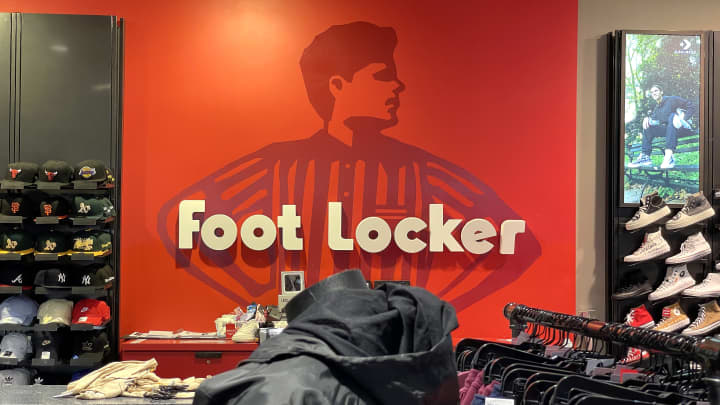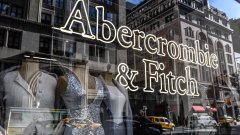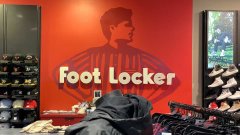
Shares of plummeted about 30% on Wednesday after the sneaker retailer reported a holiday-quarter loss, issued weak guidance for the current year and said it's behind on meeting its financial goals.
Given how poorly its past fiscal year went, the company is now expecting the profitability goal it laid out during its March 2023 investor day to be delayed by two years, Foot Locker's Chief Financial Officer Mike Baughn said. It now anticipates reaching an EBIT margin of 8.5% to 9% by 2028, said Baughn.
Here's how the company did in its fiscal fourth quarter, compared with estimates from analysts surveyed by LSEG, formerly known as Refinitiv:
The company swung to a loss in the three-month period that ended Feb. 3. Foot Locker lost $389 million, or $4.13 per share, compared with income of $19 million, or 20 cents per share, a year earlier. Excluding one-time items, Foot Locker reported earnings of 38 cents per share.
Sales rose slightly to $2.38 billion, up about 2% from $2.34 billion a year earlier.
In the current fiscal year, Foot Locker is expecting profit to be worse than analysts had expected. It anticipates adjusted earnings per share will be between $1.50 and $1.70, compared with estimates of $1.40 to $2.30, according to LSEG. It's expecting sales to be between down 1% to up 1%, compared with estimates of down half a percent, according to LSEG.
With the plunge Wednesday, Foot Locker has lost more than half its market value since May 2021.
CEO Mary Dillon said in a statement that Foot Locker managed to drive full-price sales "in addition to compelling promotions" during its holiday quarter. But as the retailer wound down its fiscal year, Foot Locker marked down more items to clear out excess inventory, primarily in its apparel category. As a result, "higher markdowns" drove Foot Locker's gross margin down by 3.5 percentage points.
"As we continue evolving into a modern, omnichannel retailer for 'all things sneakers,' we are making important progress strengthening our brand partnerships, increasing customer engagement, transforming our real estate footprint, and driving growth in digital," said Dillon.
It has been a little over a year since Dillon took the helm of Foot Locker. During her tenure, sales have consistently fallen as the retailer grappled with a changing mix of sneaker brands and a target consumer that has felt the brunt of inflation more acutely than those in higher-income brackets.
Foot Locker has also been repositioning its Champs Sports brand and has grappled with high inventory levels that, unlike its peers, it has struggled to curb. During the quarter, Foot Locker relied on markdowns to reduce inventory levels by 8.2% compared with the prior year.
In her past life as chief executive, Dillon skillfully won over buzzy beauty brands and turned the company into a powerhouse cosmetics retailer. When she took over as Foot Locker's top boss in September 2022, she was seen as the savior the legacy retailer sorely needed.
While Dillon inherited a slew of problems that existed long before she took over, and is still highly regarded across the retail industry, her turnaround of Foot Locker has come more slowly than some analysts had expected.
Dillon said the company still managed to see some positive results during the quarter despite a "dynamic" overall retail and economic environment. Overall comparable sales decreased 0.7%, which is better than the company had projected and the 7.9% drop that analysts had expected, according to StreetAccount. Comparable sales at Foot Locker and Kids Foot Locker in North America increased 5.2%
The company made strides in building out its online sales channels, and digital revenue now accounts for about 20% of Foot Locker's overall mix. Foot Locker is working to get that number to 25% by 2026.
Dillon has built out the executive leadership team and has made changes to its merchant and buying teams, along with its finance organization, "to ensure inventory accountability and enhanced forecasting."
The company has also signed a new marketing deal with the NBA, made plans to enter India and said it's on its way to achieving its long-term goals.
Dillon has also worked to revamp Foot Locker's store footprint. Many of the retailer's stores are in underperforming malls, and Dillon wants the company to focus on more experiential stores that are better suited for the communities they operate in. During the fourth quarter, Foot Locker opened 29 new stores, remodeled or relocated 66 locations, and closed 113 stores.
Last March, Dillon touted a renewed and revitalized relationship with , which has long been the largest driver of Foot Locker's sales. She has also sought to reduce the company's reliance on the sneaker giant as it has focused on driving direct sales and squeezing out wholesalers.
During the quarter, Nike accounted for 60% of overall sales, down from about 63% in the year-ago quarter. Dillon said the company is seeing more revenue come from buzzy sneaker brands like On Running and Hoka, as well as legacy brands like Adidas, New Balance and Ugg.
The relationship between the two brands still appears to be in a state of flux. On earnings calls, Nike routinely points to and as its treasured wholesale partners.
But in mid-February, Foot Locker announced a new partnership with its longtime supplier. The partnership, dubbed The Clinic, brings together Foot Locker, Nike and the Jordan Brand, and will feature "interactive activations, high reach media, real life basketball clinics, social media content, community events and more."
The partnership officially launched during the 2024 NBA All-Star Game in Indianapolis.
"It's important to note our relationship our partnership with Nike is strong," said Dillon on a call with analysts. "The areas that we really align around are our basketball, kids and sneaker culture, especially with the fact that we have a younger, multicultural consumer that we bring to the party and so, you know, a perfect example of how we're working together is the activation we just did with them."
Read the full earnings release .
Don't miss these stories from CNBC PRO:




